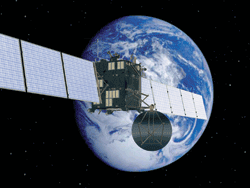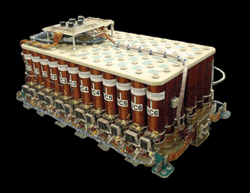Satellite batteries must offer function and evolution
Batteries are critical for the proper functioning of a satellite in space and must function to allow optimum satellite operation
BY ANNIE SENNET-CASSITY
Saft
Cockeysville, MD
http://www.saftbatteries.com
Television broadcasting, cell phones, GPS navigation, military surveillance, NASA science experiments — each of these is possible because of satellites. Batteries are a critical part of a satellite’s ability to operate in space. Here’s why we need batteries in satellites and what aspects of batteries are important in ensuring mission success.
Batteries in satellites
When a satellite is in orbit around the earth, the sun‘s light allows the solar panels located on either side of the satellite to generate power from their photovoltaic solar cells. However, satellites must depend on a second power source because the earth’s daily rotation blocks the satellite from the sun either on a daily basis or during certain times of the year, depending on the satellite.
This is where batteries come in. How long the satellite uses the batteries for energy (as opposed to the solar panels) depends on the type of orbit in which the satellite is placed.
There are several different types of orbits in which satellites can revolve around the earth. The main types are Low Earth Orbit (LEO), Medium Earth Orbit (MEO), and Geostationary Earth Orbit (GEO). Each orbit type places a different level of demand on the battery.

Fig. 1. Satellites aid communication, navigation, and security. (Photo courtesy of ESA AOES Media lab.)
In GEO, satellites are placed directly over the plane of the equator and aimed at a fixed spot on the globe, which allows them to have the same exact orbit speed as the earth so they stay in the same spot at all times. In this position, satellites take 24 hours to rotate the earth; and, for eclipse seasons (two 45-day periods a year), they use batteries for 0 to 72 minutes per day. Batteries for such GEO satellites — used primarily for telecommunications, military, and meteorological systems — must last 15 to 18 years.
In contrast to GEO satellites, LEO satellites are placed much closer to the earth’s surface (anywhere from 160 to 1,000 km above earth) and rotate quicker, taking only 90 minutes to circle the earth. In this position, the satellite is eclipsed for 30 to 40 minutes per day so the batteries endure about 5,000 cycles per year. LEO satellites are typically used for space stations and civil, scientific or military observation, which require repeated radio contacts with ground stations.
Between the extremes of GEO and LEO satellites are MEO satellites, which are used primarily for global positioning systems. They are placed at an altitude of between 1,000 km and 30,000 km and circle the earth in about 24 hours, though they do not have the same rotation speed as the earth. These satellites are eclipsed by the sun from 0 to 80 minutes during eclipse seasons, for two periods of 40 to 60 days per year. Batteries for MEO satellites must endure about 170 cycles a year.
Aside from the number of battery cycles required in each type of orbit, other parameters that affect the battery’s function in the satellite include the depth of discharge (DOD) and temperature. DOD is the percentage of the battery capacity discharged during the eclipse.
In a rapidly cycling LEO satellite, the DOD will be limited so that it does not overstress the batteries. For a GEO satellite, it will be higher as the battery is only used 90 days per year.
In terms of temperature, satellites are exposed to a wide range of temperatures from launch to orbit and during its journey around the earth. Therefore, the battery must be reliable enough to withstand extreme changes in temperature.
Making batteries for space
The space environment itself places many demands on satellite batteries, in terms of cycles, DOD, and temperature. Batteries are also taxed during launch because of the vibrations of the launch vehicle.
Aside from these physical demands, the commercial and military satellite industries are risk averse because of the financial investment involved in satellite missions. Therefore, it is critical that the batteries are manufactured to be safe and reliable, and to last the duration of the mission, often up to 15 years.
When looking for a battery, satellite manufacturers consider not only the battery technology, but also flight heritage and the battery manufacturer. Other aspects of consideration are that all the same materials are sourced from the original vendors and the battery and cells are made by consistent, approved written procedures and processes, without deviation. It typically takes 5 years from the time a battery is made to the launch date because of stringent qualification and testing. This is because (with rare exceptions) once the satellite is launched, it cannot be repaired nor can it have its individual cells replaced.
The failure of the battery can mean a lost mission. That’s why satellite makers look for suppliers who make electrochemical cells that are nearly exact replicas of one another, in addition to having a proven heritage in space.
Technology evolution
In the 1960s, nickel-cadmium (NiCd) was the primary technology used for satellites, and it is still used to some extent today for LEO satellites that require lower levels of power. NiCd batteries are reliable, simple to manage, have a low self-discharge, and a strong heritage in space.
However, they are also very heavy and therefore don’t always meet the higher-power, lower-weight requirements for many of today’s satellites. In the 1990s, nickel-hydrogen (Ni-H2 ) batteries began to replace NiCd, especially in GEO satellite because of their high energy over mass ratio.
The Li-ion advantage
Today’s satellite makers are looking for technologies that reduce the overall size of the satellite because of the costs of manufacturing and launching the satellite. A lighter, smaller battery allows more mass/volume on the satellite for more transponders (communication satellites), heavier science components (NASA missions) or lower launch costs. Although Ni-H2 significantly reduces satellite weight compared to NiCd, lithium-ion (Li-ion) technology reduces weight even more due to its higher specific energy.
Lower thermal dissipation is another source of weight reduction for Li-ion. Combined with higher energy and better charge efficiency, this lets the satellite maker reduce the size of the satellites’ solar panels.

Fig. 2. Saft batteries used in satellites
Li-ion has numerous other advantages over NiCd and Ni-H2 , including low self-discharge, wide operating temperature, and superior charging efficiency. Li-ion batteries retain about 96% to 98% of their charge even after a month of storage and need no recharging when they are about to be launched, as is the case with Ni-H2 . Li-ion batteries can operate from 0° to 40°C, and they are easily recharged, further simplifying operation and maintenance. ■
For more on batteries, visit http://www2.electronicproducts.com/Power.aspx.
Fig. 1. Satellites aid communication, navigation, and security. (Photo courtesy of ESA AOES Media lab.) Fig. 2. Saft batteries used in satellites
Advertisement
Learn more about Saft Batteries





